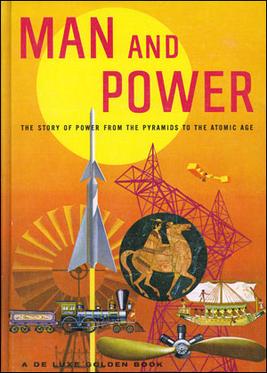Man and Power facts for kids

Cover of Man And Power
|
|
| Author | L. Sprague de Camp |
|---|---|
| Illustrator | Russ Kinne, Roman Vishniac, Alton S. Tobey and others |
| Country | United States |
| Language | English |
| Subject | Engineering |
| Publisher | Golden Press |
|
Publication date
|
1961 |
| Media type | Print (Hardback) |
| Pages | 189 pp |
Man and Power: The Story of Power from the Pyramids to the Atomic Age is an exciting science book written for young people by L. Sprague de Camp. It was first published in 1961 by Golden Press. The book is filled with interesting facts, photographs, and amazing paintings by Alton S. Tobey, showing how humans have learned to use different kinds of power throughout history.
This book takes you on a journey through time, exploring how people have discovered and used power, from ancient times to the modern age. It covers everything from simple human strength to the incredible energy of the atom. You'll learn about the different ways power has shaped our world and made incredible inventions possible.
Contents
- Understanding Power: A Journey Through Time
- Manpower: The First Power Source
- Animal Power: Our First Helpers
- Wind Power: Harnessing the Air
- Water Power: The Flow of Energy
- Steam Power: The Age of Machines
- Internal-Combustion Power: Fueling Our World
- Chemical Power: Energy from Reactions
- Electric Power: The Modern Age
- Nuclear Power: Unlocking the Atom
Understanding Power: A Journey Through Time
This book explores the amazing story of how humans have learned to use power. It covers many different types of power, showing how our understanding has grown over thousands of years. From the strength of people and animals to the force of wind and water, and then to more complex sources like steam and electricity, the book explains it all.
Manpower: The First Power Source
Long ago, before machines, human strength was the main source of power. People used their muscles to build huge structures like the Egyptian pyramids. They also used their strength for farming, hunting, and moving heavy objects. This "manpower" was essential for early civilizations. Even today, human power is important for many tasks.
Animal Power: Our First Helpers
After humans, animals became a key source of power. Horses, oxen, and donkeys helped with farming, pulling carts, and carrying goods. This made work much easier and faster. Animals allowed people to farm larger areas and travel further. They were like the first living engines, helping societies grow and develop.
Wind Power: Harnessing the Air
Imagine using the invisible force of the wind! For centuries, people have used wind power. Sailboats used wind to travel across oceans, allowing exploration and trade. Windmills used wind to grind grain into flour or pump water. Wind power is a clean and renewable energy source that is still used today, especially with modern wind turbines.
Water Power: The Flow of Energy
Water has always been a powerful force. People learned to use flowing water to turn wheels, which could then power mills for grinding grain or sawing wood. These "water wheels" were some of the earliest machines. Water power was very important for early industries. Today, we use hydroelectric power plants to generate electricity from the force of falling water.
Steam Power: The Age of Machines
The invention of the steam engine in the 1700s changed the world forever. Steam engines used boiling water to create steam, which then pushed pistons to create motion. This led to the Industrial Revolution. Steam engines powered trains, factories, and ships. They allowed for mass production and faster transportation, making goods cheaper and travel quicker.
Internal-Combustion Power: Fueling Our World
The internal combustion engine is what powers most cars, motorcycles, and airplanes today. These engines burn fuel (like gasoline or diesel) inside a chamber to create a powerful explosion. This explosion pushes parts of the engine, making it move. This type of engine made personal transportation and air travel possible, connecting the world in new ways.
Chemical Power: Energy from Reactions
Chemical power comes from reactions between different substances. For example, batteryies use chemical reactions to produce electricity. Explosives, like those used in mining or construction, also release energy through chemical reactions. Even the food we eat gives us energy through chemical processes in our bodies!
Electric Power: The Modern Age
Electricity is one of the most versatile forms of power. It can be generated in many ways, like from burning coal, using water (hydroelectric), or from nuclear reactions. Once generated, electricity can be sent through wires to power homes, schools, and factories. It runs our lights, computers, televisions, and countless other devices, making modern life possible.
Nuclear Power: Unlocking the Atom
Nuclear power uses the energy stored inside the tiny parts of atoms. This energy is released in a controlled way inside nuclear reactors. It creates a lot of heat, which is used to boil water and make steam. This steam then turns turbines to generate electricity. Nuclear power plants produce a lot of electricity with very little fuel, but they also require careful handling of radioactive materials.

